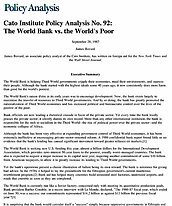The World Bank’s raison d’etre in its early years was to encourage development. Now, the bank exists largely to maximize the transfer of resources to Third World governments. And by so doing, the bank has greatly promoted the nationalization of Third World economies and has increased political and bureaucratic control over the lives of the poorest of the poor.
Bank officials are now leading a rhetorical crusade in favor of the private sector. Yet every time the bank loudly praises the private sector, it silently damns its own record. More than any other international institution, the bank is responsible for the rush to socialism in the Third World–the rise of political power over the private sector–and the economic collapse of Africa.
Although the bank has been very effective at expanding government control of Third World economies, it has been extremely ineffective at encouraging private-sector-oriented reform. A 1986 confidential bank report found little or no evidence that the bank’s lending has caused significant movement toward greater reliance on markets.[1]
The World Bank is seeking new U.S. funding this year, almost a billion dollars for the International Development Association, which provides zero-interest 50-year loans to the poorest, usually worst-managed countries. The bank also is expected to request a major increase in its capital next year, requiring another commitment of some $10 billion from American taxpayers, to allow it to greatly increase its lending to Third World governments.
Yet the bank’s operations present a classic illustration of failure being its own reward. The bank is notorious for giving bad advice. In the 1970s it helped to lay the groundwork for the Ethiopian government’s current murderous resettlement program.[2] Bank aid has helped many countries build unneeded steel factories, underused airports, and roads that crumble as soon as they are completed.
The World Bank is currently run like a Soviet factory, concerned only with meeting its quantitative production goals. Bank president Barber Conable, in a recent interview with Le Monde, declared, “The 1986–87 fiscal year, which ended on June 30, was a success: our commitments represented $14.2 billion as against $13 billion the previous fiscal year.”[3]
It is surprising that the bank would consider itself a “success” simply because oppressive governments in Ethiopia and Mozambique and inept governments around the globe accepted more zero-interest 50-year loans or other bank-subsidized aid. According to the bank’s own auditors, bank projects have suffered from “unseemly pressure” to lend more money.[4] Bank officers have pressured Third World governments to borrow more than they wished to borrow, a practice having dire results for the country, as unnecessary bank projects have turned out to be prize boondoggles.
A Congressional Research Service study concluded in 1980, “The Bank is seen as presiding over the buildup of debts which will ultimately be defaulted.”[5] In 1986 the Economist noted, “The Bank failed to anticipate the debt crisis that erupted in 1982.”[6] Despite the fact that 56 Third World countries have now fallen behind in their debt repayments, the bank continues to push for ever greater lending–both by itself and by commercial banks–to Third World governments.[7]
It wasn’t always like this. From the bank’s creation in 1946 until the late 1960s, the bank was a conservative institution that primarily funded infrastructure and other basics in less developed countries (LDCs). In 1968, Robert McNamara became bank president and dedicated the bank to achieving ever higher loan levels. Between 1968 and 1981, when McNamara resigned, the bank’s lending levels increased twelvefold, from $883 million to over $12 billion, and they have continued soaring since then.
The only thing the bank has left is the nobility of its original mission: to lift the poor nations of the world out of poverty. But it provides far more help to Third World politicians and bureaucrats than to Third World citizens. And most of all, the bank continues helping itself by doling out ever larger amounts of money.


